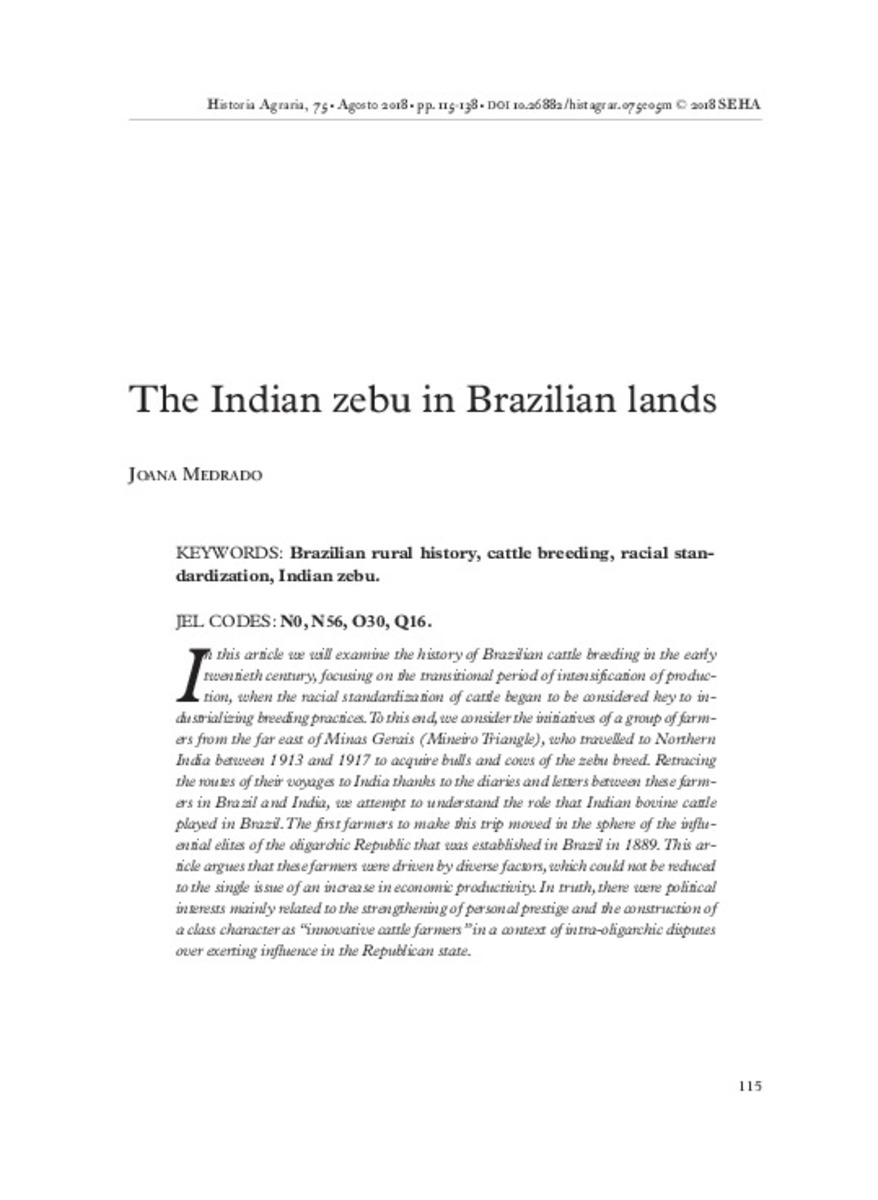| dc.contributor.author | Medrado, Joana | |
| dc.date.accessioned | 2018-06-25T09:47:10Z | |
| dc.date.available | 2018-06-25T09:47:10Z | |
| dc.date.issued | 2018-08 | |
| dc.identifier.issn | 1139-1472 | |
| dc.identifier.uri | http://hdl.handle.net/10234/175322 | |
| dc.description.abstract | In this article we will examine the history of Brazilian cattle breeding in the early twentieth century, focusing on the transitional period of intensification of production, when the racial standardization of cattle began to be considered key to industrializing breeding practices. To this end, we consider the initiatives of a group of farmers from the far east of Minas Gerais (Mineiro Triangle), who travelled to Northern India between 1913 and 1917 to acquire bulls and cows of the zebu breed. Retracing the routes of their voyages to India thanks to the diaries and letters between these farmers in Brazil and India, we attempt to understand the role that Indian bovine cattle played in Brazil. The first farmers to make this trip moved in the sphere of the influential elites of the oligarchic Republic that was established in Brazil in 1889. This article argues that these farmers were driven by diverse factors, which could not be reduced to the single issue of an increase in economic productivity. In truth, there were political interests mainly related to the strengthening of personal prestige and the construction of a class character as “innovative cattle farmers” in a context of intra-oligarchic disputes over exerting influence in the Republican state. | ca_CA |
| dc.description.abstract | Neste artigo iremos analisar parte da História da Pecuária Brasileira do começo do século XX, focando no período de transição para a intensificação produtiva quando a padronização do rebanho bovino começou a ser considerada a chave do processo de industrialização da produção. Para tanto, vamos investigar a iniciativa de um grupo de fazendeiros do extremo oeste de Minas Gerais (Triângulo Mineiro) que pessoalmente foram ao norte da Índia entre 1913 e 1971 para adquirir reprodutores das raças zebu, registrando suas trajetórias de viagem em diários e cartas trocadas entre os fazendeiros no Brasil e na Índia. Nesse sentido, tentaremos entender o papel que o zebu desempenhou no Brasil. Esses primeiros fazendeiros que foram à Índia orbitavam muito próximo às elites influentes na República Oligárquica, instaurada no Brasil em 1889. O argumento que se pretende tecer neste artigo é que os fazendeiros que trouxeram o zebu da Índia eram movidos por diversos interesses que não podem ser reduzidos ao aumento da produtividade econômica. Na verdade, havia intereses políticos precipuamente relacionados ao fortalecimento do prestígio pessoal e da construção de um atribuo de classe enquanto «vanguarda pecuarista» em um contexto de disputas intraoligárquicas para manter certa influência no Estado republicano | ca_CA |
| dc.format.extent | 24 p. | ca_CA |
| dc.format.mimetype | application/pdf | ca_CA |
| dc.language.iso | eng | ca_CA |
| dc.publisher | Sociedad Española de Historia Agraria (SEHA) | ca_CA |
| dc.relation.isPartOf | Historia agraria: Revista de agricultura e historia rural, nº 75, p. 115-138 | ca_CA |
| dc.rights | © 2018 SEHA | ca_CA |
| dc.rights | Attribution-NonCommercial-NoDerivatives 4.0 Internacional | * |
| dc.rights.uri | http://creativecommons.org/licenses/by-nc-nd/4.0/ | * |
| dc.subject | Brazilian rural history | ca_CA |
| dc.subject | historia rural brasileña | ca_CA |
| dc.subject | cattle breeding | ca_CA |
| dc.subject | racial standardization | ca_CA |
| dc.subject | Indian zebu | ca_CA |
| dc.subject | história do Brasil | ca_CA |
| dc.subject | história rural | ca_CA |
| dc.subject | padronização racial | ca_CA |
| dc.subject | pecuária | ca_CA |
| dc.subject | zebú indiano | ca_CA |
| dc.title | The Indian zebu in Brazilian lands | ca_CA |
| dc.type | info:eu-repo/semantics/article | ca_CA |
| dc.subject.jel | N0 | ca_CA |
| dc.subject.jel | N56 | ca_CA |
| dc.subject.jel | O30 | ca_CA |
| dc.subject.jel | Q16 | ca_CA |
| dc.rights.accessRights | info:eu-repo/semantics/openAccess | ca_CA |
| dc.relation.publisherVersion | http://historiaagraria.com/numero.php?n=75 | ca_CA |








